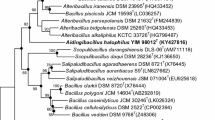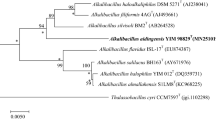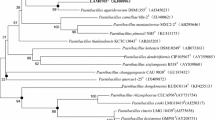Abstract
Three novel Gram-positive, endospore-forming bacteria were isolated from a cold and alkaline environment. Phylogenetic analysis showed that the strains were almost identical, and that they were related to Natronobacillus azotifigens 24KS-1T (95.8% identity), Paraliobacillus quinghaiensis YIM-C158T (95.1%), Paraliobacillus ryukyuensis O15-7T (94.5%), and Halolactibacillus miurensis M23-1T (93.9%). The isolates produced amylase, α-galactosidase, β-galactosidase, and β-glucuronidase, and showed optimal growth at pH 10, at 20°C, and at 2–8% (w/v) NaCl. Major fatty acids were C14:0 (10.6–11.6%), anteiso-C15:0 (25.7–32.7%), C16:1 ω11c (12.2–16.0%), and C16:0 (14.0–20.4%). The major polar lipids were diphosphatidylglycerol and phosphatidylglycerol, and meso-diaminopimelic acid was found in the cell-wall peptidoglycan. The G+C content was 38.4%. DNA–DNA hybridization between strain GCM68T and H. miurensis M23-1T was 32.4%, while hybridization to N. azotifigens 24KS-1T, Amphibacillus tropicus Z-7792T, and Paraliobacillus ryukyuensis O15-7T was below 30%. The phylogenetic analysis and G+C content place strain GCM68T in relation to species belonging to Bacillus rRNA group 1, but phylogenetic and physiologic data combined with chemotaxonomic analyses support our proposal for a new genus, Alkalilactibacillus, gen. nov., with the novel species Alkalilactibacillus ikkensis, sp. nov. (type strain is GCM68T = DSM 19937 = LMG 24405).

Similar content being viewed by others
References
Ash C, Farrow JAE, Wallbanks S, Collins MD (1991) Phylogenetic heterogeneity of the genus Bacillus revealed by comparative analysis of small-subunit-ribosomal RNA sequences. Lett Appl Microbiol 13:202–206
Buchardt B, Seaman P, Stockmann G, Vous M, Wilken U, Düwel L, Kristiansen A, Jenner C, Whitticar MJ, Kristensen RM, Petersen GH, Thorbjørn L (1997) Submarine columns of ikaite tufa. Nature 390:129–130
Buchardt B, Israelson C, Seaman P, Stockmann G (2001) Ikaite tufa towers in Ikka Fjord, Southwest Greenland: their formation by mixing of seawater and alkaline spring water. J Sediment Res 71:176–189
Cao SJ, Qu JH, Yang JS, Sun Q, Yuan HL (2008) Halolactibacillus alkaliphilus sp. nov., a moderately alkaliphilic and halophilic bacterium isolated from a soda lake in Inner Mongolia, China, and emended description of the genus Halolactibacillus. Int J Syst Evol Microbiol 58:2169–2173
Carrasco IJ, Marquez MC, Yanfen X, Ma Y, Cowan DA, Jones BE, Grant WD, Ventosa A (2006) Gracilibacillus orientalis sp. nov., a novel moderately halophilic bacterium isolated from a salt lake in Inner Mongolia, China. Int J Syst Evol Microbiol 56:599–604
Cashion P, Hodler-Franklin MA, McCully J, Franklin M (1977) A rapid method for base ratio determination of bacterial DNA. Anal Biochem 81:461–466
Chen YG, Cui XL, Zhang YQ, Li WJ, Wang YX, Xu LH, Wen ML, Peng Q, Jiang CL (2009) Paraliobacillus quinghaiensis sp. nov., isolated from salt-lake sediment in China. Int J Syst Evol Microbiol 59:28–33
De Ley J, Cattoir H, Reynaerts A (1970) The quantitative measurement of DNA hybridization from renaturation rates. Eur J Biochem 12:133–142
Huβ VAR, Festl H, Schleifer KH (1983) Studies on the spectrophotometric determination of DNA hybridization from renaturation rates. Syst Appl Microbiol 4:184–192
Ishikawa M, Ishizaki S, Yamamoto Y, Yamasato K (2002) Paraliobacillus ryukyuensis gen. nov., sp. nov., a new Gram-positive, slightly halophilic, extremely halotolerant, facultative anaerobe isolated from a decomposing marine alga. J Gen Appl Microbiol 48:269–279
Ishikawa M, Nakajima K, Itamiya Y, Furukawa S, Yamamoto Y, Yamasato K (2005) Halolactibacillus halophilus gen. nov., sp. nov. and Halolactibacillus miurensis sp. nov., halophilic and alkaliphilic marine lactic acid bacteria constituting a phylogenetic lineage in Bacillus rRNA group 1. Int J Syst Evol Microbiol 55:2427–2439
Johansen A, Olsson S (2005) Using phospholipid fatty acid technique to study short-term effects of the biological control agent Pseudomonas fluorescens DR54 on the microbial microbiota in barley rhizosphere. Microb Ecol 49:1–10
Lane DJ (1991) 16S/23S rRNA sequencing. In: Stackebrandt E, Goodfellow M (eds) Nucleic acid techniques in bacterial systematics. Wiley, New York, pp 115–175
Logan NA, Berge O, Bishop AH, Busse HJ, De Vos P, Fritze D, Heyndrickx M, Kämpfer P, Rabinovitch L, Salkinoja-Salonen MS, Seldin L, Ventosa A (2009) Proposed minimal standards for describing new taxa of aerobic, endospore-forming bacteria. Int J Syst Evol Microbiol 59:2114–2121
Mansfeld-Giese K, Larsen J, Bødker L (2002) Bacterial populations associated with mycelium of the arbuscular mycorrhizal fungus Glomus intraradices. FEMS Microbiol Ecol 41:133–140
Mesbah M, Premachandran U, Whitman W (1989) Precise measurement of the G+C content of deoxyribonucleic acid by high performance liquid chromatography. Int J Syst Bact 39:159–167
Rhuland LE, Work E, Denman RF, Hoare DS (1955) The behavior of the isomers of α,ε-diaminopimelic acid on paper chromatograms. J Am Chem Soc 77:4844–4846
Sambrook J, Russell DW (2001) Commonly used techniques in molecular cloning, Molecular cloning: A laboratory manual, vol 3. Cold Spring Harbor Laboratory Press, Cold Spring Harbor
Schmidt M, Stougaard P (2010) Identification, cloning and expression of a cold-active β-galactosidase from a novel Arctic bacterium, Alkalilactibacillus ikkense. Environ Technol 31:1107–1114
Schmidt M, Priemé A, Stougaard P (2006) High microbial diversity in permanently cold and alkaline ikaite columns from Greenland. Extremophiles 10:551–562
Sorokin ID, Zadorina EV, Kravchenko IK, Boulygina ES, Tourova TP, Sorokin DY (2008) Natronobacillus azotifigens gen. nov., sp. nov., an anaerobic diazotrophic haloalkaliphile from soda-rich habitats. Extremophiles 12:819–827
Stougaard P, Jørgensen F, Johnsen MG, Hansen OC (2002) Microbial diversity in ikaite tufa columns: an alkaline, cold ecological niche in Greenland. Environ Microbiol 4:487–493
Valderrama MJ, Monteoliva-Sanchez M, Quesada E, Ramos-Cormenzana A (1998) Influence of salt concentration on the cellular fatty acid composition of the moderately halophilic bacterium Halomonas salina. Res Microbiol 149:675–679
Wainø M, Tindall BJ, Schumann P, Ingvorsen K (1999) Gracilibacillus gen. nov., with description of Gracilibacillus halotolerans gen. nov., sp. nov.; transfer of Bacillus dipsosauri to Gracilibacillus dipsosauri comb. nov., and Bacillus salexigens to the genus Salibacillus gen. nov., as Salibacillus salexigens comb. nov. Int J Syst Bacteriol 49:821–831
Zerbino DR, Birney E (2008) Velvet: algorithms for de novo short read assembly using de Bruijn graphs. Genome Res 18:821–829
Zhilina TN, Garnova ES, Tourova TP, Kostrikina NA, Zavarzin GA (2001) Amphibacillus fermentum sp. nov., Amphibacillus tropicus sp. nov., new alkaliphilic, facultatively anaerobic, saccharolytic bacilli from Lake Magadi (English translation of Mikrobiologiia). Microbiology 70:711–722
Zhilina TN, Garnova ES, Tourova TP, Kostrikina NA, Zavarzin GA (2002) Amphibacillus fermentum sp. nov. and Amphibacillus tropicus sp. nov. In validation of publication of new names and new combinations previously effectively published outside the IJSEM, List no. 85. Int J Syst Evol Microbiol 52:685–690
Acknowledgments
We acknowledge Michael Hansen for doing the SEM microscopy and Dorte Rasmussen and Karin Vestberg for technical assistance. Professor Jean Euzéby, University of Toulouse, is thanked for guidance in nomenclature. Referring to the Convention on Biological Diversity, we thank the Greenland Home Rule for permission to sample ikaite columns from the Ikka Fjord. This work was partly funded by the Villum Kann Rasmussen Foundation and the The Danish Council for Technology and Innovation.
Author information
Authors and Affiliations
Corresponding author
Additional information
Communicated by A. Oren.
The GenBank/EMBL/DDBJ accession number for the 16S rRNA gene sequence of Alkalilactibacillus ikkensis strain GCM68T is EU281853.
Electronic supplementary material
Below is the link to the electronic supplementary material.
792_2012_430_MOESM1_ESM.doc
Supplementary Figure 1. Scanning electron microscopy pictures of strain GCM68T, showing the rod shaped cells of 1.5-5 μm in length and around 0.5 μm in width. Furthermore, cells performing binary fission can be seen as long chains of only partly separated cells. (DOC 322 kb)
792_2012_430_MOESM2_ESM.doc
Supplementary Figure 2. Growth of strain GCM68T at different temperatures and pH. Liquid cultures in shake flasks were inoculated with strain GCM68T and samples were withdrawn for OD600 measurements at the time intervals indicated. Growth was investigated at pH 6, 7, and 8 (not shown) and at pH, 9 (dashed lines, ♦), pH 10 (solid lines, ■) and pH 10.7 (initial pH; dotted lines, ▲). The shake flasks were incubated at 10°C, 20°C, and 25°C. The pH values at the end of the growth experiment were measured to pH 9, 10, and 10.5, respectively. All incubations were in triplicates. (DOC 380 kb)
792_2012_430_MOESM3_ESM.doc
Supplementary Figure 3. Growth rate of strain GCM68T at different temperatures and pH. Regression lines were drawn from the growth curves in Supplementary Fig. 2 in the exponential growth phase. The pH values at the end of the growth experiment were measured to pH 9, 10, and 10.5, respectively. Open bars, 10°C; solid bars, 20°C; hatched bars, 25°C. (DOC 23 kb)
792_2012_430_MOESM4_ESM.doc
Supplementary Figure 4. Growth of strain GCM68T at increasing concentrations of NaCl measured in Deep Well microtiter plates. The concentrations ranged from 0 to 25% NaCl, and growth was investigated at pH 10 at 5, 15, and 25°C. The figure shows that isolate GCM68T grows in the range from 0 to 10% NaCl with optimal growth from 2 to 8% NaCl. (DOC 28 kb)
792_2012_430_MOESM5_ESM.doc
Supplementary Figure 5. Measurement of pH in growing cultures in shake flasks. The growth media were adjusted to pH 6.0 - 8.0 using NaH2PO4/Na2HPO4, to pH 8.5 - 9.0 using NaHCO3/HCl, and to 9.4 - 11.5 using NaHCO3/Na2CO3. Samples were withdrawn for pH measurements at the time intervals indicated. (DOC 163 kb)
792_2012_430_MOESM6_ESM.doc
Supplementary Figure 6. Neighbor Joining phylogenetic tree showing strains GCM68T, GCM74 and GCM75 and their closest relatives within the rRNA group 1 in the phyletic assemblage classically defined as the genus Bacillus. Sequences were retrieved from NCBI database, trimmed in length, and aligned with the CLC Main Workbench 5.0 software (CLC bio). Bootstrap (n=100) values are shown. Bar, 0.022 substitutions per nucleotide position. (DOC 140 kb)
Rights and permissions
About this article
Cite this article
Schmidt, M., Priemé, A., Johansen, A. et al. Alkalilactibacillus ikkensis, gen. nov., sp. nov., a novel enzyme-producing bacterium from a cold and alkaline environment in Greenland. Extremophiles 16, 297–305 (2012). https://doi.org/10.1007/s00792-012-0430-7
Received:
Accepted:
Published:
Issue Date:
DOI: https://doi.org/10.1007/s00792-012-0430-7




